The list of nearly 70 battles on this and the following seven pages are those at which Napoleon personally commanded. There were literally hundreds more combat actions during this period, but those shown on pages 74-81 include most of the decisive land engagements of the major campaigns. Note how the size of the battles steadily grew until the end of 1813.
Napoleon's first major command was the Army of Italy. His was considered a secondary theater, but he surprised the Austrians and Piedmontese opposing him, and his own government, by quickly defeating the two enemy armies, forcing Piedmont out of the war and chasing the Austrians into the fortress of Mantua. He then shattered two more Austrian armies, which tried in three separate efforts to relieve the siege of Mantua (it finally surrendered in 1797). A rapid pursuit toward Vienna forced Austria to sue for peace. Europe was astounded, France had a new hero, and Napoleon believed his destiny would take him even farther.
Key
Each figure represents approximately 5,000 men, with the green bar below indicating the total number of infantry, cavalry, artillery, and other troops engaged. Troops present but not engaged, such as the Imperial Guard at Borodino, are not represented. Total losses KIA, MIA, wounded, and POWs are in red (and the occasional dark red if sources vary greatly). Napoleon's wins are in black, his defeats in red. Charts prepared using Digby Smith's Napoleonic Wars Data Book. The figures shown frequently depict the uniform styles of the different nations for each time period. For example, French infantry changed from a bicorne hat to a shako from 1805-1806.
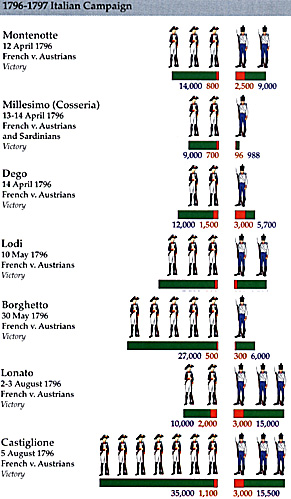
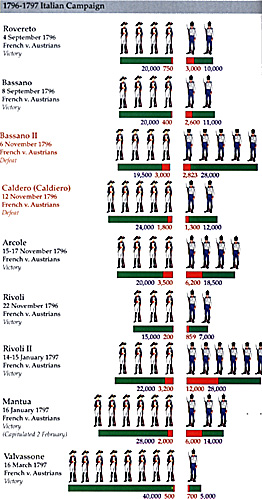
General Bonaparte's next campaign was an expedition to Egypt in 1798. He conquered it but his army was trapped there when the British navy destroyed the French warships protecting his fleet. Attempting to take Syria, Napoleon was stopped at Acre. Unable to capture this fortress, his greatly reduced army retreated back to Egypt. Leaving his army in Egypt and returning to France in 1799, he seized power and helped secure his new political position by launching a second campaign into Italy in 1800 that culminated at the battle of Marengo. (The troops in Egypt eventually returned after capitulating in 1801.)
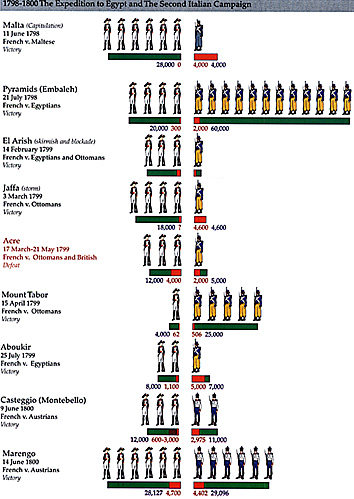
Napoleon reorganized the French military, with the primary field army called the Grande Armee. These welltrained veterans, led by experienced officers and directed by Napoleon at the height of his military prowess, seemed unstoppable. The Austrians and Russians were defeated in 1805 at Austerlitz (shown above at left), forcing Austria out of the war; then the vaunted Prussian army, created by Frederick the Great, was destroyed in 1806. The next year the Russians and remaining Prussians were defeated at Heilsburg (shown above at right) then crushed at Friedland, and Napoleon was master of Europe.
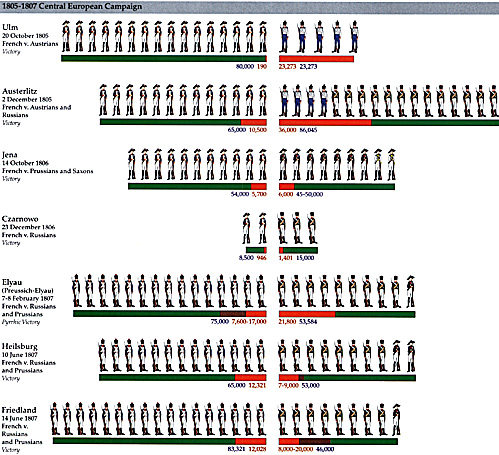
When Napoleon attempted to take over Spain and Portugal, the men he sent to do the job in 1807 failed, so he led his Grande Armee into Spain in 1808. He personally directed the troops which forced the last pass to enter Madrid and enthrone his brother Joseph. However, the Spanish, and a British army operating from Portugal, never quit fighting and contributed to Napoleon's eventual downfall. While he was busy in Spain, Austria attacked in 1809 The Emperor rushed his army to Germany, eventually defeating the Austrians for a fourth time, the campaign culminating at Wagram, shown at right. However, Napoleon's enemies were learning how to fight better, and victories were getting harder. Wagram was the largest battle seen in Europe up to this time, and it was second only to Leipzig (1813) in size.
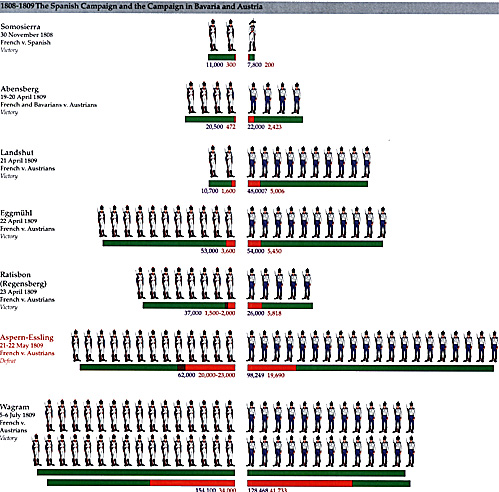
Except for the occasional small battles and constant guerrilla war in Spain, Napoleon's empire seemed secure. Because the Tsar started trading with Great Britain, Napoleon invaded Russia in 1812. The Russians avoided a major battle until Borodino, the bloodiest one-day battle of the period. The Russian army escaped annihilation and the onset of winter forced Napoleon to retreat from Moscow. The Grande Armee was destroyed by the appallingly bad weather and starvation. His enemies were encouraged to form a Sixth Coalition in 1813, but Napoleon raised a new army in an incredibly short time and fought his opponents to a standstill.
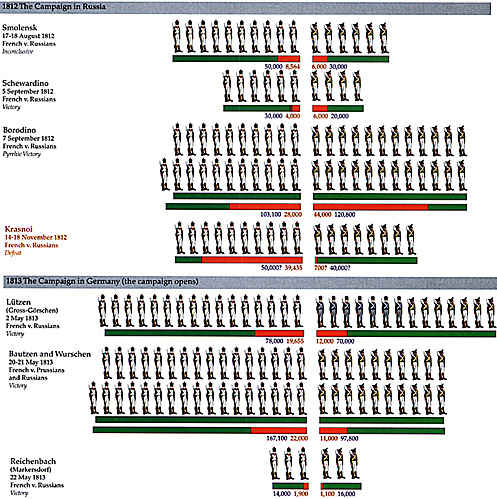
Despite the fact that his new wife, Marie-Louise, was Austrian, Napoleon was unable to keep Austria out of the war and its large army joined the forces of Prussia and Russia fighting in Germany in the second half of 1813. The largest battle of the Napoleonic Wars, and the largest Europe saw until World War I, was fought at Leipzig. That defeat demolished Napoleon's empire.
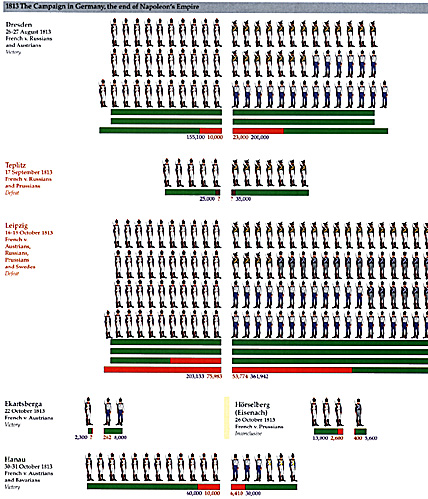
With an army greatly reduced in size through battle losses, disease, and desertion, Napoleon incredibly almost defeated the multiple armies invading France in 1814. His battlefield performance seemed like that of his first campaign in Italy in 1796, but there were too many enemies opposing him now. France was exhausted by years of war. The marshals were tired and mutinied. Marshal Marmont, his oldest friend, betrayed him by surrendering his corps and left Paris undefended. Forced to abdicate, Napoleon went into exile on the Mediterranean island of Elba.
However, he did not receive the promised retirement income, and growing unrest in France under the restored Bourbon monarch, Louis XVIII, led to another characteristic gamble: Napoleon slipped off Elba in early 1815, picked up followers on his march to Paris, and took back his throne in March. He offered the Allies peace, but they declared him an outlaw and raised armies to invade France again. The gambler chose to attack them first, before they assembled an overwhelming force. In June 1815, Napoleon led his veterans on one last campaign.
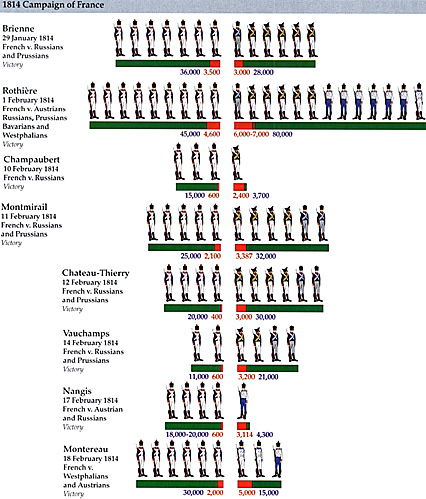
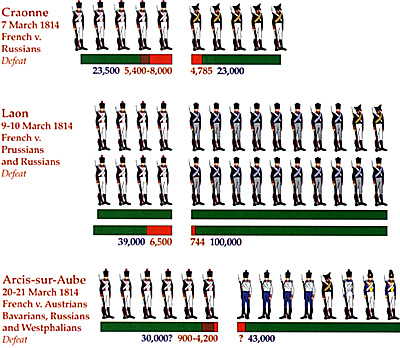
Waterloo is one of the most famous, and most decisive, battles in history. Napoleon initially defeated the Prussian army when he invaded Belgium in 1815, then fell upon a multinational, British-led army to try to end the campaign. But the Duke of Wellington's army held out until the reorganized Prussians arrived to turn the battle late in the day. Napoleon fled to Paris, but he was unwilling to continue the fight. He went into final exile on St. Helena and died there in 1821.
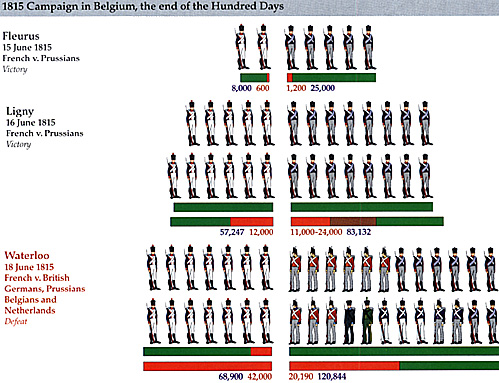
Back to Table of Contents -- Napoleon #17
Back to Napoleon List of Issues
Back to MagWeb Master Magazine List
© Copyright 2001 by Napoleon LLC.
This article appears in MagWeb (Magazine Web) on the Internet World Wide Web.
The full text and graphics from other military history magazines and gaming magazines are available at http://www.magweb.com
Order Napoleon magazine direct